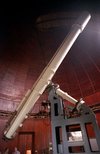Refracting telescope
|
|
TwentyInchTelescope.JPG
EightInchTelescope.JPG
A refracting or refractor telescope is a type of optical telescope which refracts light at each end using lenses. This refraction causes parallel light rays to converge at a focal point; while those which were not parallel converge upon a focal plane. This can enable a user to view a distant object as if it were brighter, clearer, and/or larger. These are similar to microscopes. The monocular is a type of refractor. A typical refractor has two lenses, an objective lens and an eyepiece lens. The objective lens has two pieces of glass (with different densities), "crown" and "flint glass". Each side of each piece is ground and polished, and then the two pieces are glued together. The curvatures are designed to cancel (limit?) chromatic and spherical aberration.
Technical difficulties
While initially the most common type of telescope, these are today used primarily by amateur astronomers and solar astronomers, and have been supplanted in professional night-time astronomy by reflecting telescopes. However, some relatively small instruments with 100-150mm objective lenses regularly produce astrophotography that rivals images created by professionals as recently as 20 years ago using what were then the largest telescopes on Earth. Vacuum solar telescopes such as the Swedish Solar Telescope often use the vacuum entrance window as a lens, and are thus refractor telescopes. The vacuum solar telescope design has produced the highest resolution images of the Sun currently available.
Refractors are criticized for their relatively high-degree of chromatic and spherical aberration. There is also the problem of lens sagging, a result of gravity affecting glass. There is a further problem of mis-refraction; caused by air bubbles trapped within the lenses. In addition, glass is opaque to certain wavelengths, and even visible light is dimmed when it passes through glass. Many of these problems are avoided by using reflecting telescopes.
Notable refracting telescopes
- Yerkes Observatory (102cm)
- Swedish Solar Telescope (100cm)
- Lick Observatory (91cm)
- Paris Observatory (83cm + 62cm)
- Nice Observatory (76cm)
See also
- List of largest optical refracting telescopes, from which it is clear that their heyday was in the 19th centuryde:Linsenfernrohr

